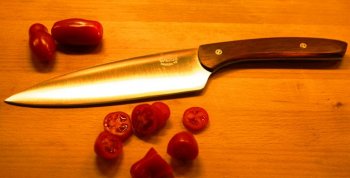I agree, go stabilized or oily/durable woods (Cocobolo, Lignum Vitae, Desert Ironwood, etc). Non stabilized knives in a kitchen environment will be exposed to moisture and humidity and will move around more. Also, food can get into the pores of the wood, etc. Be careful of stabilized wood though. I have used some from some places and it moved, curled, shrunk, pulled off of the tangs, etc. Pieces that are in my shed where it's cold laid flat against the tang and swelled a bit, but moved when I brought them back inside. Not all stabilized wood is treated equally!! If I was to send wood out, K&G and WSSI would be my first 2 choices; I have used a bunch of wood done by both places and it was beautiful.
If it's too "plasticy" feeling, then use a coarser finish. I played with woods using 12000 Micro Mesh sandpaper and also faux pearl with the same Micro Mesh paper. The Plastic feels like plastic, the wood still feels more wood like, even highly polished, but they were too slick for my tastes. They looked beautiful, but almost too shiny; it was hard to get pics of the handle and pin since they were so reflective. Since the MM is a sandpaper, there was some grip to it when it was wet, but felt slicker when it was dry. A sisal wheel and white compound works OK, but can remove material if you push too hard on it. I switched to the Jantz Matchless White and a sewn Muslim buff or Polishing wheel; it doesn't remove much material and only polishes. It also doesn't affect the polish on the metal tang and stuff as much. After buffing, I wipe down with Denatured alcohol to remove the wax residue and then apply Tung Oil or Tru Oil and rub in a few coats to bring back the wet look and bring out the grain. It gives a nice feel to it that's smooth, but not as slippery feeling.

